(Ranger Auto Hub Left – Warn Manual Hub – Right)
Often times when there is a hub failure you know right away because when you go to check it, it’s gone. All you’ll be left with is the mounting plate behind the wheel.
For others however, the problem isn’t as obvious. In fact, we’ve seen people sell 4-wheel drive Ranger’s cheap because the 4-wheel drive wasn’t working when the only problem was with the automatic locking hubs.
Automatic Hubs (1983-1997):
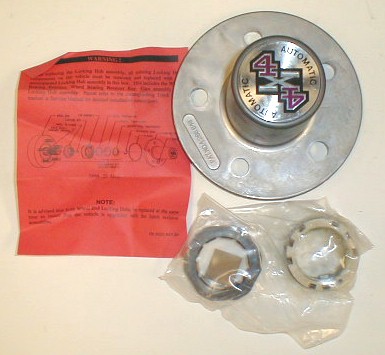
With automatic hubs, there is no need to stop or get out of the vehicle to lock them in. The spring-loaded hub automatically engages on the fly when the transfer case is shifted from 2WD into 4WD. The application of torque to the axle causes the splined collar inside the hub to slide on to the axles splined stub shaft and lock.
The automatic hubs used on the 1983-1997 Rangers have caused many Ranger owners a lot of trouble. They will click and grind and make ratcheting noises instead of engaging. Before deciding that the hubs are bad, you should take them off and inspect them.
If there is excess grease in the hub body, the cams cannot engage completely. Some people feel they need to pack the hub with grease. This can actually cause them to not operate properly.
If the hubs are dirty or packed with grease they’ll need to be cleaned. Take a can of brake cleaner and clean all the grease off the spindle and axle sub shaft splines. Fill the hubs with brake cleaner a couple times, working the spring mechanism up and down, and empty it. Try to get all the grease out. Letting hot ATF (transmission fluid) fluid set in them for a half hour and then dumping it out will also help.
Don’t put grease in the hubs. Just lubricate them with a little automatic transmission fluid (ATF).
If your automatic hubs are shot and you want a reliable hub off-road, you should perform a manual hub swap. For more information, click HERE. We also have an article HERE. A better upgrade is the Warn Jeep Hubs as discussed HERE.
Manual Hubs (1983-1997):
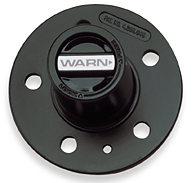
To figure out what’s wrong (if anything) with your manual hubs, you have to understand how they work;
Your locking hubs on your Ranger have a flange base that slides over the wheel studs. The tire then goes on over the locking hub. On the inside of the hub is a spring and splined collar. When you turn the knob on the hub to lock them in, you force the splined collar to slide down over the splines on the axles stub shaft. This engages the wheel and locks it to the axle shaft. If the splined collar does not engage the splines on the output shaft, the wheel will not be locked in.
There are (3) reasons why the front hub may not engage the axle shaft and work:
1) There is to much grease or other crap in the hub to allow the splined collar to fully engage the splines on the axle shaft.
2) The washer (spacer) is missing behind the snap ring on the axle shaft allowing it to travel and disengage from the hub.
3) The internal components of the hub are broke.
If the hubs are dirty or packed with grease they’ll need to be cleaned. Take a can of brake cleaner and clean all the grease off the spindle and axle sub shaft splines. Fill the hubs with brake cleaner a couple times, working the spring mechanism up and down, and empty it. Try to get all the grease out. Letting hot ATF (transmission fluid) fluid set in them for a half hour and then dumping it out will also help.
Don’t put grease in the hubs. Just lubricate them with a little automatic transmission fluid (ATF).
If you wish to disassemble these, all you need is a flat blade and Phillips screwdriver and some shop or paper towels. Take the snap ring out of the inside, and it all more or less slides apart.
Pulse Vacuum Hubs (PVH) (1998-2000):
The 1998-2000 PVH hubs was definitely not one of Ford’s better ideas. We constantly see people complaining about these hubs not working. Most likely your problem is in the vacuum lines. You’ll need to follow the lines and try to find the leak.
Your best bet is to replace them with manual hubs. For more information, click HERE.
Another option is to swap parts from a 1995 & Newer Explorer that did not use the PVH hubs. For more information, click HERE.
Live Axle Assembly (2001 & Newer):
Your 2001 and newer has what is called a “live axle” which simply means that the cv’s are physical attached to the hubs via a nut and spin at a constant speed with the wheels. On this truck the disconnect is the transfercase. However, what you can do is convert your truck to a ’98-’00 1/2 style Ranger knuckle. The difference here is that for these 2 years for used what was called a Pulse Vacuum Hub, basically a vacuum operated locking hub. And you’re in luck, AVM makes a manual locking hub for it. What you will need is the bearing assembly from a PVH year truck (new or scrap yard), the CV shafts from said year truck, hubs (AVM), and if you go the new route on the bearings you will have to source a snap ring that hold the cv axle into the hub from Ford. From there it’s just unbolt your stock stuff and bolt on the new. It’s pricey, and takes a little bit of work, but totally do able.
More Automatic Hubs (1983-1997):
Clean the parts off thoroughly. Then do a visual inspection for cracks, chips, bends, stripped threads and the such. The weakest link in the automatic hub is the plastic cam. Check the teeth for breaking, shaving, rounded edges, grease, etc (See Illustration 1-1). There shouldn’t be any grease on the teeth which could make it slip during engagement. Inspect the splines for wear and the spacers (plastic and metal) (See Illustration 1-2).
If you encounter a loud clicking or grinding when you are attempting engagement, then it could be either the plastic cam (Illustration1-1) covered with grease, or the hub body itself is shot (Illustration 1-2). The way to test the hub body is to remove the piece from inside the cam assembly and set it on the inner side of the hub like it’s supposed to go (See Illustration 1-3 and 1-4). Now when engaged, the hub receives pressure towards the cap and it locks the hub up. So, squeeze the ends of the hub together and you should feel it sink down about 3/8″. At this point, try to turn the hub while still squeezing it still (See Illustration 1-5). If the hub doesn’t turn, try to force it, if it still doesn’t, then the body assembly is ok, if the hub still turns freely, then the hub body is shot.
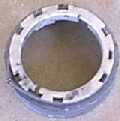
Illustration 1-1
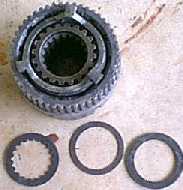
Illustration 1-2
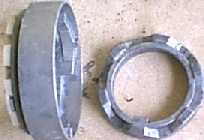
Illustration 1-3
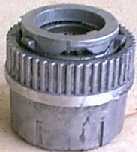
Illustration 1-4
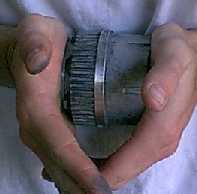
Illustration 1-5
Notice: We’re looking for a diagram or photos showing how the hubs engage the axle shaft and work. If you have anything, Contact us.

